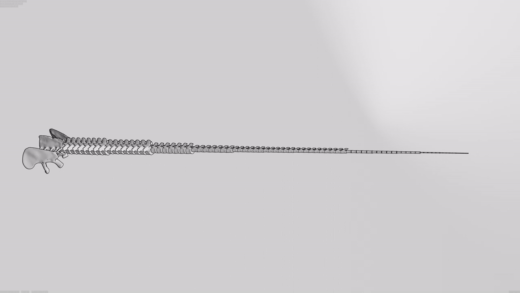Did long-necked dinosaurs' whip-like tails really break the sound barrier? Not so fast.
New research contradicts the claim that diplodocids could whip their tails at supersonic speeds. Instead, it was a (still impressive) 62 mph.

Similar in length to a semitruck, diplodocids could whip their long, sinuous tails as fast as a big rig cruising down the highway at 62 mph (100 km/h), a new study reveals.
The investigation, published Dec. 8 in the journal Scientific Reports, contradicts a previous claim that the long-necked dinosaurs, which are a group of sauropods that lived during the Middle Jurassic to the Lower Cretaceous periods (174 million to 101 million years ago), could crack their bullwhip-like tails as fast as the speed of sound at sea level (about 761 mph, 1,225 km/h). Instead, their tails' true speed would have been closer to that of a motor vehicle.
To investigate, scientists examined the fossils of five separate diplodocids and created a digital model of a tail using measurements they took of the remains.
The resulting model tail measured approximately 39 feet (12 m) long, weighed 3,188 pounds (1,446 kilograms) and contained 82 cylinders, which represent its vertebrae, according to a statement.
"There are only a few specimens available, and of those, only two had complete tails that we could use for our purposes," Simone Conti, the study's lead author and a doctoral student studying aerospace engineering and paleobiology at the NOVA School of Science and Technology in Portugal, told Live Science. "After gathering data from the specimens and adjusting the dimensions of their tails, we created a model and tried to replicate the [speed of sound] results from the other study."
Related: Long-necked dinosaurs probably had even longer necks than we thought
However, instead of cracking the sound barrier, the tail in the new model crumbled under the sheer velocity of being forced to thrash back and forth at such high speeds.
Sign up for the Live Science daily newsletter now
Get the world’s most fascinating discoveries delivered straight to your inbox.

"Most likely the failure was caused by the soft tissues that connect each of the vertebrae in the tail, which include the different muscles, tendons, ligaments and skin," Conti said. "Whenever the simulation failed, we noticed that the model tail couldn't simulate the joints between the vertebrae and would overstretch. Achieving such high speeds had its limitations, and they couldn't handle moving that fast and we would lose pieces of the tail."
Conti called the model simulation a "new approach" that combines his academic work straddling aerospace engineering and paleobiology.
"Not many studies have been done using these methods," Conti said. "In aerospace engineering, it's common to test parts of airplanes to see how much stress the structures can sustain. We wanted to test the same approach but on the organic materials of animals. It's not common to see aerospace engineering and paleontology working together."
While the purpose of the dinosaur's whip-like tail is unknown, researchers speculate that "from the shape of it, it has always been compared to a whip," Conti said. "From a morphological point of view, it probably was used as a weapon or a way to communicate between one another."
Jennifer Nalewicki is former Live Science staff writer and Salt Lake City-based journalist whose work has been featured in The New York Times, Smithsonian Magazine, Scientific American, Popular Mechanics and more. She covers several science topics from planet Earth to paleontology and archaeology to health and culture. Prior to freelancing, Jennifer held an Editor role at Time Inc. Jennifer has a bachelor's degree in Journalism from The University of Texas at Austin.










